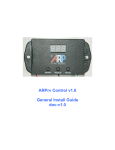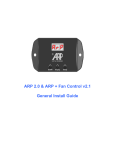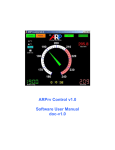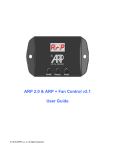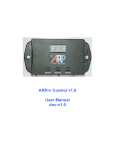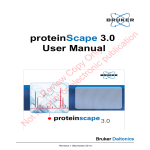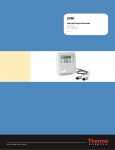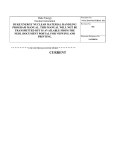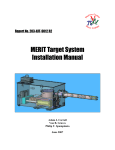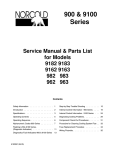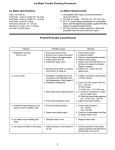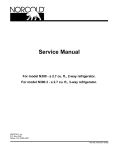Download ARP Control User Manual v1.2
Transcript
ARP Control User Manual v1.2 Terms -- Conditions & Contact Information This manual is copyrighted by ARPC L.L.C.. All rights are reserved. This manual may only be reproduced with permission of ARPC L.L.C.. This manual is furnished for informational use only and is subject to change without notice. This manual does not imply any commitment on the part of ARPC LLC or its business partners. ARPC L.L.C. and its business partners assume no responsibility or liability for any error or inaccuracies that may appear in this manual. By use of this document for installation and operation of the ARP Control, the user is agreeing to the ARPC L.L.C. terms and conditions found in document ARPC LLC License Agreement.pdf. The document "ARPC LLC License Agreement.pdf" can be downloaded at web address https://sites.google.com/site/arprvsafer/-8-documentation-and-downloads or, please send any request to e-mail address below, ARPC L.L.C. will supply information in a timely manner: [email protected] CONTENTS SAFETY .................................................................................................................................... 1 1.1 Acronyms and Abbreviations ....................................................................................... 1 1.2 Hazard Information ...................................................................................................... 1 1.3 Work Safely ................................................................................................................. 1 1.4 Terns & Warnings Symbols ......................................................................................... 1 1.5 Operation Safety.......................................................................................................... 1 INTRODUCTION ....................................................................................................................... 1 INSTALLATION ........................................................................................................................ 1 3.1 System Components ................................................................................................... 1 3.2 Supplies & Tools.......................................................................................................... 2 INSTALLATION - RTD.............................................................................................................. 2 4.1 Mounting the Temperature Sensor .............................................................................. 2 INSTALLATION - CONTROLLER ............................................................................................ 6 5.1 Location....................................................................................................................... 6 5.2 Interior Location........................................................................................................... 6 5.3 Mount Housing Inside.................................................................................................. 6 5.4 Exterior Mounting ........................................................................................................ 6 5.5 Mount Housing Exterior ............................................................................................... 7 WIRING the ARP ...................................................................................................................... 7 6.1 General Information..................................................................................................... 7 6.2 Good Wiring Practices................................................................................................. 7 6.3 Wiring the Ground ....................................................................................................... 7 6.4 Wiring the Power ......................................................................................................... 8 6.5 Wiring the Relay .......................................................................................................... 8 6.6 Temperature Sensor Wiring ........................................................................................ 9 6.7 Wiring Options ............................................................................................................. 9 OPERATION ........................................................................................................................... 11 7.1 Initialization of the ARP Controller ............................................................................. 12 7.2 Button Sequence & Control Functions....................................................................... 12 7.3 ARP Control Modes................................................................................................... 12 7.4 EZ Set-Point Method ................................................................................................. 12 7.5 Control-Low Set-Point Method................................................................................... 12 7.6 Auto Tuning ............................................................................................................... 12 7.7 ARP Control Mode..................................................................................................... 13 7.8 Displaying Boiler Temperature .................................................................................. 13 7.9 Displaying Circuit Temperature ................................................................................. 13 7.10 Relay Test ............................................................................................................... 13 7.11 Error Message ......................................................................................................... 13 7.12 ARP Modes and Button Selection Flow Charts ....................................................... 13 7.13 Set-Up Mode Variable Definition ............................................................................. 15 CONCLUSION ........................................................................................................................ 15 © 2013 ARPC L.L.C. All rights reserved. ARP Control User Manual DRAFT v1.2 11/10/2013 © 2013 ARPC L.L.C. All rights reserved. 1 SAFETY 1.1 Acronyms and Abbreviations 1.4 Terms & Warnings Symbols ARP: ARP Control GND: Ground NC: Normally Closed Relay Contact NO: Normally Opened Relay Contact P/N: Part Number RTD: ARP Control temperature sensor; Resistance temperature detector is the type of sensor used. 1.2 Hazard Information Hazard information includes terms, symbols and instructions used in this manual or on the equipment to alert operating and service personnel to the recommended precautions in the care, use and handling of the ARP. 1.3 Work Safely There are many ways to install the ARP. Make safety your first priority! The installer’s knowledge, skill, and ability are important for safely installing the system. If you are unsure of your ability to do the installation, have a qualified installer do the work. 1.5 Operation Safety The ARP Control and 'ARPrvSafe' infer that the use and operation of this control can add a level of safety to your absorption refrigeration system in your RV. No other RV absorption refrigerator control monitors the boiler temperature, and turns off the heat source to the refrigerator before damage can be done to the internal fluids in the refrigerator cooling unit. The ARP cannot prevent RV refrigerator failure if the manufacture built the cooling unit in a manner that would result in premature failure INTRODUCTION The ARP is a monitoring device for RV refrigerators. The ARP turns off your cooling unit heat source if refrigeration is not taking place. The ARP control will automatically attempt to restart your refrigerator five times. RV absorption refrigerators work by boiling a fluid mixture that includes water and ammonia. The ammonia turns into a gas that rises and separates from the water mixture. It then condenses into a liquid that flows through the cooling unit tubing. As it does this, it absorbs heat thereby cooling the refrigerator. RV refrigerators are notoriously unsafe when operated off-level or in a variety of temperature and pressure conditions. If the boiler in your RV refrigerator overheats, the cooling tubes are stressed which may lead to early failure or even a rupture that leads to a fire. The ARP monitors the actual boiler temperature of your RV refrigerator to detect conditions that can be unsafe, and in turn, turn off the boiler heat source to prevent overheating. INSTALLATION 3.1 System Components The ARP is not complicated. The system has the following components seen in Fig. 1. • • • • Controller Temperature Sensor (RTD) Relay Fuse ARP Control User Manual DRAFT v1.2 11/10/2013 © 2013 ARPC L.L.C. All rights reserved. The RTD sensor measures the temperature of the boiler process tube. The controller looks at this information and is programmed to send a signal to open the normally closed (NC) relay when a condition exists that may indicate overheating. Depending on the control ordered, a variety of functions can be used to interact with the control and its program. The control can also gather data that can be stored on your computer system. All these features add up to a universal control that is also a powerful diagnostics tool never applied before to RV refrigeration. Optional supplies for the installation of the ARP: • Cable Clamps (Ace Hardware P/N: PPC1525; Radio Shack P/N: 640-3039) • 0.25" Piggy-Back Crimp Connector (Handy for connection of ARP power supply to Norcold power supplies with standard automotive power supply connectors) Fish Tape (To push or pull wires between RV and cooling unit compartment) Optional clips for RTD attachment (ACE Hardware -- Hilman Hardware 58410) Metal Repair Tape (ACE Hardware P/N: 47523) Buzzer for audible alarm (Radio Shack P/N: 273-0059) Red flashing LED for visual alarm (Radio Shack P/N: 276-0056) LED holder (Radio Shack P/N: 276-0079) Blower, this fan is better suited for controlling heat than the typical muffin fans (DELTA P/N: BFB1012L) • • 3.2 Supplies & Tools • Needed supplies for the installation of the ARP: • • • • Dielectric Grease or Silicon Grease (Walmart or NAPA Auto Parts 'Sil-Glyde') Super Glue Fiber Glass Insulation (Typical Hardware Store High Temp Pipe Wrap; Granger Item #: 4LFD2; McMaster-Carr P/N: 9356K11) 2 • • • INSTALLATION - RTD 4.1 Mounting the Temperature Sensor Fig. 2 is a drawing of a typical RV which includes the living space and the refrigerator installation. The exterior shell of the RV, including the cooling unit access door, is removed for ease of viewing. This figure gives the installer a general idea of what will be found inside the cooling unit compartment. The temperature sensor clips onto the boiler process tube. Fig. 5 shows a cutaway view of the boiler assembly and the RTD with clip. 1. Open the access door to expose the rear of the refrigerator. 2a. For refrigerators that have metal boiler housings, open the heater access door as seen in Fig. 4. To open the door, there is a tab that goes into the slot seen in Fig.4, straighten the tab and open the door. Once the door clears the heaters, push the door up to unlock the lower hinge. Now the door can be removed. 2b. For refrigerators that have foil boiler housing, such as the Norcold 1200, pull out the section of insulation inserted with the Norcold recall. Please reference the document found at our web site on page [9] Documents and Downloads, file: Norcold recall documentation 1B01CB9Cd01.pdf ARP Control User Manual DRAFT v1.2 11/10/2013 © 2013 ARPC L.L.C. All rights reserved. 3 Relay Green/White (RTD) Twisted Pair Wire Black (ARP Relay)/White (GND) Twisted Pair Wire Red (+)/White (GND) Twisted Pair Wire Fig. 1 ARP Control Kit Fig. 2 Cutaway of Typical Cooling Unit Installed in RV ARP Control User Manual DRAFT v1.2 11/10/2013 © 2013 ARPC L.L.C. All rights reserved. 4 Fig. 3 Typical Inside View of Refrigerator Installation 3. Push the insulation aside to allow you to identify the various tubes. The insulation may also be removed by removing sections to gain access to the tubing inside. that insulation can be placed between the boiler process tube and the RTD wires. Note: If the clip is glued in the wrong position, use Acetone to release the supper glue. Do not get Acetone on the wire end of the RTD. 4. You will mount the sensor to the boiler process tube. This tube is most easily identified by the fact that the electrical heater mount tubes are welded directly to the boiler process tube. Most Norcold refrigerators have a flue tube on the back of the boiler tube as viewed looking into the boiler housing. Dometic cooling units generally have the flue in front of the process tube. The location of the flue tube determines the RTD housing and clip alignment in step 5. As seen in Fig. 5, the RTD clip is aligned for a Dometic installation because the clip is to the left of the RTD as seen in this view. The Norcold clip is opposite; the clip would be to the right as seen in Fig. 6. 5. Referencing Fig. 5, the RTD and clip are shown, where the RTD has been supper glued to the clip for ease of installation. Note that the wires exiting the RTD housing are aligned away from the center of the clip so Fig. 4 Boiler Housing with Open Heater Access Door ARP Control User Manual DRAFT v1.2 11/10/2013 © 2013 ARPC L.L.C. All rights reserved. 6. Determine the position of the RTD so that it meets the following criteria: • • • • The sensor is touching the boiler process tube. The sensor is away from all heat sources including the flue tube. The sensor is a least 1” above the electric heating elements, preferably 2" to 5". The maximum height is below the upper absorber coil seen in Fig. 5. Fig. 5 shows a typical Dometic installation of the ARP RTD. The red tube seen in this figure is the gas flue tube, make sure the RTD is not in contact with this tube, and the RTD is very well insulated from this heat source. 7. Once the position of the RTD has been determined, either spray silicone lubricant, or rub silicone grease on the clip and the boiler tube to aid with step 8 below. Snap the RTD around the boiler process tube very near the location you determined. 8. Position the RTD to meet the criteria in step 6 above by sliding the RTD from side to side, or up and down. 9. Repack the insulation you may have moved. Pack extra insulation around the sensor and between the sensor and any heat sources such as the flue tube and the electric heaters. Referencing Fig. 6, pack insulation around the clip and in the direction of the green arrows. This will help prevent the flue tube and electric heaters from affecting the RTD measurement and insure an accurate measurement of the boiler process tube. Fig 5 Install Temperature Sensor Fig. 6 Insulate RTD 5 ARP Control User Manual DRAFT v1.2 11/10/2013 © 2013 ARPC L.L.C. All rights reserved. 6 INSTALLATION - CONTROLLER 5.1 Location Decide whether you will install the ARP controller inside the living space of the RV or in the exterior access door for the cooling unit. Either way works, if you like to view the control data frequently, you may want it inside. If you do not want to run wiring inside the living compartment, then the exterior installation may work best for you. The general approach to installation is the same regardless of where you decide to mount the components. Referencing the figures, you will need to locate the following features of your RV refrigeration system: • • • Cooling unit access door (louvered door that accesses the rear of the refrigerator) Refrigerator manufacturers' control unit Suitable power supply 5.3 Mount Housing Inside Fig. 7 Mount Housing & Route Wires Fig 7 shows the ARP housing mounted. A wire routing hole was drilled in the back of the housing and aligned with the previous section routing hole. Then, the screws are inserted and the wires are then routed. 5.2 Interior Location 5.4 Exterior Mounting Fig. 3 is a drawing of the inside view for a typical RV refrigerator installation. Please note the black ARP housings which represent possible locations to mount the ARP inside the RV. These are some suggestions for mounting locations that have spaces behind them for routing the wires. Most Dometic refrigerators have a wiring conduit from inside, behind the refrigerator controls to the cooling unit area, this makes it possible to mount directly on the refrigerator control panel. Fig. 8 Typical Exterior Installation Once the best location for the controller is decided upon, drill the wire routing hole in the interior of the RV. Generally a 1/4" hole is adequate. Next, if needed, push a wiring fish tape through the hole to make sure that the wires can be routed successfully to the cooling unit compartment. Tip: Often removal of the roof vent will allow ease of wiring. Fig. 8 shows a typical installation where the ARP is installed on the manufactures' control box. Most of the manufactures controls have 1/4" of clearance between the components inside the box and the outside housing where the ARP is mounted. Please remove the cover to the manufactures' control and check the clearances if in doubt before drilling any of the screw pilot holes. ARP Control User Manual DRAFT v1.2 11/10/2013 © 2013 ARPC L.L.C. All rights reserved. 7 5.5 Mount Housing Exterior Fig. 9 shows three 1/4" holes drilled near to the bottom edge of the control housing. This allows any water to drain and the wires to be routed as seen in Fig. 1 or 8 above. Fig. 9 Drill Drain/Wire Routing Holes WIRING the ARP 6.1 General Information Due to variations in refrigerator design to which you may be adding the ARP, the description of how to wire your particular refrigerator may not be listed here. If you have any difficulty, please contact our technical support. Once installed, we recommend you periodically test the ARP relay to insure that the ARP and also the manufactures' control are operating correctly. All absorption RV refrigerators work on similar principles. You can connect the ARP control to turn off the heat source of your absorption refrigerator using one of three methods: 1. Stop power from reaching the manufacture’s refrigerator controller. 2. Stop power from reaching the manufactures’ flame sensor if the refrigerator has a manual control. 3. Stop power from reaching the wire going to or from the manufacturer’s temperature monitoring device, such as the boiler thermo-switch or NHTSA type recall kit. Note: The ARP adds a higher level of safety than most NHTSA kits because the ARP measures boiler temperature and turns off the heat source at a lower temperature to avoid damaging the unit. CAUTION The ARP does not interfere with the NHTSA or other kits provided by the manufactures if and only if the ARP is installed correctly. The ARP must be connected so that the NC relay terminal is connected in series with the manufactures’ safety device allowing the manufactures’ safety device to perform its normal operation. Do not disable manufacturer safety devices. 6.2 Good Wiring Practices • • • Always disconnect all power sources before working on any electrical circuit. Make the ground connection first. This is important because most circuits use the ground connection for safety and overload prevention. Make the ground connections at a single point whenever possible. This helps to avoid ground loops that interfere with digital controls function. See Fig. 10. 6.3 Wiring the Ground ARP Control Manufactures' Control Boiler Housing Burner Housing and SOV Valve 12VDC RV Power Supply Singular Grounding Point Fig. 10 Single Grounding Point The RV battery ground should always be the final destination of any grounded circuit in your RV. The battery ground is connected to the chassis of the RV. You may need to consider how the ground circuit in your RV connects to the battery. Grounding requires experience. If you are unfamiliar with ground ARP Control User Manual DRAFT v1.2 11/10/2013 © 2013 ARPC L.L.C. All rights reserved. 8 circuits, consult our technical support or a professional installer. Use the following steps to connect the ground for the ARP: 1. Identify the 2 white ground wires extending from the ARP controller. They are twisted in pairs with the black and red wires from the ARP. 2. Identify the ground location of your refrigerator. By viewing Fig. 11 & 12, the typical power and ground terminals are seen. Connect the 2 white ground wires identified in Fig. 1 to the ground of your system. You can use the ground screw terminal, or another similar ground. 3. Verify that the boiler housing is grounded. The boiler housing acts as a shield for the ARP sensor. This housing should be grounded or the ARP will pick up “noise” from sources such as the gas SOV valve and the gas igniter. This step is not always necessary, but is recommended. Fig. 12 Typical Norcold Power Terminals 1. Locate the red wire extending from the ARP housing, this wire will go to the fuse. Note 1: The fuse is rated at 2-3 amps. Note 2: The fuse will also supply power to the relay in the next section. 2. Connect the wire from the fuse to the refrigerators 12VDC power supply. If you cannot locate the power supply or your system is different, contact technical support. There are many ways you can power the ARP. 6.5 Wiring the Relay Fig. 11 Typical Dometic Power Terminals 6.4 Wiring the Power Often the best place to connect the power for the ARP controller is the manufactures’ control 12VDC input. Use the following method to connect the ARP to the power source. The ARP uses a typical automotive type single pole double throw (SPDT) 30A relay. You may use the relay connection to power to a buzzer, LED, or other device to alert you that the ARP has determine an overheating condition, as well as to shut down power to the refrigerator. Note: A 30 amp relay works for most applications. If higher amperage is needed, a 40 amp relay is readily available. Fig. 13 shows the general ARP relay wiring. In addition to wiring your own alarm, the relay can be wired to turn off the heat source to the refrigerator using one of three methods as mentioned in section 6.1. An easy method to connect the relay is the following: ARP Control User Manual DRAFT v1.2 11/10/2013 © 2013 ARPC L.L.C. All rights reserved. Warning ARP Control Power Supply Control Interrupt OUT 87 ARP Control Relay Activation 87a 2 or 3 Amp Fuse 9 86(+) 30 85(-) Power Supply 85(-) 86(+) 87 Control Interrupt IN Relay Bottom View Relay Isometric View Fig. 13 ARP Relay Terminal Connections 30 is wired to the +12VDC power supply that will be interrupted by the NC relay switch, or any supply that is desired to cut power to the manufactures' control. 85 (–) is wired to the ARP black wire. The ARP grounds the relay through this terminal. 86 (+) is wired through the fuse to +12VDC power supply. CAUTION The installer must be carful to not reverse the polarity on terminals 85 and 86. The reverse polarity will result in failure of the switching device within the ARP. Always test all of the control functions after installation. 87a is wired to the 12VDC power supply to the manufactures' control which is interrupted when the ARP senses a boiler overheat situation. 87 can optionally be wired to any type of alarm that will inform the operator of an overheat situation, more on this subject below. When the ARP control activates the normally closed (NC) relay terminal, it opens this circuit, turning off the power to the manufacturers' refrigerator controller. 30 is connected to the power side of the NC switch. To connect it, locate the +12VDC connection to the manufacturer’s refrigerator controller, disconnect the wire from the +12VDC source where it connects to the manufacturers' refrigerator controller. Reconnect this wire to relay terminal 30. Note: You may need to protect this circuit with an additional fuse of appropriate size inline with the power supplied to the relay. Ensure that all power connections are properly fused. 87a is wired so as to supply power through the NC relay connection to the manufactures' refrigerator controller. The ARP will attempt to restart your refrigerator, in most cases before the internal temperature of the refrigerator can rise. When the ARP releases the relay, it returns to its normally closed position and power is restored to the refrigerator controller, so it resumes its typical operation. 87a is connected as the load side of the NC switch. 6.6 Temperature Sensor Wiring The RTD temperature sensor is connected to the ARP via a green/white twisted wire pair. Note: The white wire of this pair is not a ground wire. The RTD wires are not polarized; they may be installed in either position on the sensor, please see Fig. 1. 6.7 Wiring Options The following section uses engineering wiring schematics, where the power and ground are shown as rails on top and bottom of the schematic. All of the components are between the power rails. Please use the ARP Control User Manual DRAFT v1.2 11/10/2013 © 2013 ARPC L.L.C. All rights reserved. 10 numbers to Fig. 13, where the numbers for the terminals are shown in isometric, schematic, and relay bottom views. Fig. 15 to 18 is for reference, please contact technical support with any questions. manufactures' wiring diagram to confirm the proper connections for a particular installation. Fig. 14 shows a general wiring scheme, on the right of the schematic the relay is shown. Please compare the following relay terminal 12VDC Power Rail (+) Warning Fuse Control Interrupt OUT 85 12VDC RV Power Supply 87 87a 30 86 Control Interrupt IN RTD Twisted Pair Cable Identifier (-) Ground Rail Fig. 14 General Wiring 12VDC Power Rail (+) Fuse2 - Optional. Rated for Manufactures's Control Fuse1 2-3 Amp 85 12VDC RV Power Supply 86 87 87a Manufactures' Controller 30 Twisted Pair Cable Identifier RTD (-) Ground Rail Fig. 15 Typical Universal Wiring 12VDC Power Rail (+) Fuse2 - Optional Fuse1 2-3 Amp 85 12VDC RV Power Supply 86 RTD (-) 87 87a Manufactures' Controller 30 Twisted Pair Cable Identifier Flashing LED Fig. 16 Typical Dometic or Norcold Wiring Boiler Housing Thermal Switch ARP Control User Manual DRAFT v1.2 11/10/2013 © 2013 ARPC L.L.C. All rights reserved. 11 12VDC Power Rail 85 12VDC RV Power Supply 86 RTD (-) 87 87a Manufactures' Controller 30 Norcold High Temperature (~800°F) Monitoring Kit Twisted Pair Cable Identifier Ground Rail Fig. 17 Norcold 1200 Series with High Temp. Monitoring Kit 12VDC Power Rail (+) Fuse1 2-3 Amp 85 12VDC RV Power Supply 86 RTD (-) 87 87a Manufactures' Controller 30 Twisted Pair Cable Identifier Fuse2 - Optional Ground Rail DPDT Control Switch Flashing LED Fig. 18 ARP Mounted in Cooling Unit Compartment & Alarm inside RV OPERATION Fig. 19 ARP Control Panel Audible Alarm ARP Control User Manual DRAFT v1.2 11/10/2013 © 2013 ARPC L.L.C. All rights reserved. 7.1 Initialization of the ARP Controller You operate the ARP using the buttons on its front panel. Information is displayed using bar and dot LEDs in the display area. Once the ARP has been properly installed, you must run the ARP Auto Tune function to set the parameters unique to your refrigerator. After setting Auto Tune, there are two setpoint methods: EZ Set-Point Method (Control-High) and the operator adjustable Control-Low Set-Point Method, more on these modes below. 7.2 Button Sequence & Control Functions Referencing Fig.20, the ARP has three push buttons. The On/Off button on the left is purely a momentary push-button, where momentary means to press the button and release it immediately. The center Display, and right SetUp buttons are used as both momentary and press-hold buttons depending on the function desired. 7.3 ARP Control Modes The ARP has 4 modes of operation which perform different tasks as follows: 1. ARP Control Mode: This mode is initiated by momentarily pressing the On/Off button. Within this mode, there are two set-point methods described below. 2. Recording Mode: This mode will not activate the ARP relay if there is a boiler over heat situation. This mode is purely for diagnostics. This mode is initiated by holding down the center Display button, momentarily press the On/Off button. When the display shows SP0, release the Display button. 3. Auto Tune Mode: Defined below in section 7.6. 4. Set-Up Mode: This mode is for operator adjustments if the user does not want to run the controller using the EZ Set-Point Method. 12 7.4 EZ Set-Point Method After Auto Tune is complete, and the control is in the ARP Control mode, the ARP begins detecting excessive boiler temperatures using default parameters. When an excessive temperature is reached, the ARP opens the relay to turn off power, stopping your refrigerator from overheating. After an appropriate cool-down period, the ARP signals the relay to close and the normal refrigerator operation resumes. As a safety measure, the ARP makes 5 attempts to resume normal operation before locking out the restoration of power to the refrigerator device. At this point you must resolve the conditions that are causing the boiler to overheat. WARNING If the ARP attempts to restore the heat source to your refrigerator and fails, the operator must determine if there is an unsafe condition present, and remedy the cause of the unsafe condition. Turning off the ARP and restarting your refrigerator should be preformed by qualified service personal that are capable of dealing with any issues that may arise. 7.5 Control-Low Set-Point Method This control method is for advanced users that want to fine tune the ARP for their particular refrigerator to achieve its maximum protection. The operator must place the ARP into the Set-Up mode to activate this setpoint method. Please see Fig. 20 and the Troubleshooting Guide for more on this subject. 7.6 Auto Tuning Auto Tune must be run the first time the ARP is powered on. For most installations, Auto Tune will only need to be run once. To Auto Tune the ARP perform the following steps: 1. Hold down both the Display and Setup buttons and then momentarily press the On/Off button to start the Auto Tune mode. 2. When the ARP front panel displays At, release all buttons. ARP Control User Manual DRAFT v1.2 11/10/2013 © 2013 ARPC L.L.C. All rights reserved. 3. If possible, allow the ARP to run in the Auto Tune mode for 24 hours. If this is not possible, allow Auto Tune to run for at least two refrigeration cycles. A refrigeration cycle is when the refrigerator thermostat turns the unit on and then off again as it reaches the refrigerated compartment temperature. In hot weather this may not be possible. If this is the case, it is recommended to freeze a gallon of water to put in the refrigerator, then manually turning the refrigerator off for about an hour, and then turn it back on for the 2nd cycle. Note: Please see detailed instructions for adjusting the SP variable in the Troubleshooting Guide when it is not possible to allow your refrigerator to be turned off for an extended period of time before setting Auto Tune. 4. When you are finished running Auto Tune, press the On/Off button. This will turn off the ARP and save all of the parameters. 7.7 ARP Control Mode After running Auto Tune, press the On/Off button again to turn on the ARP Control mode. The ARP automatically defaults to the EZ Set-Point Method after Auto Tune. At this point you are ready to use the ARP if the operator does not want to change the setpoint method to C-L. The ARP is now monitoring the temperature at the sensor location and will open the relay if overheating is detected. 7.8 Displaying Boiler Temperature The boiler temperature may be displayed on the LED during all modes of operation with the exception of the Set-Up mode. Press and hold the Display button to show the measured boiler temperature. Release the button to turn off the temperature display. 13 7.9 Displaying Circuit Temperature When in ARP Control mode, press and hold both the Display and SetUp buttons to show the present circuit temperature. Upon releasing the buttons, the relay will activate, press the SetUp button again to resume ARP Control mode. 7.10 Relay Test To test the ARP relay, momentarily press the SetUp button while in ARP mode. The display will read OFF, and the refrigerator and/or the heat source will be turned off if the control is functioning properly. Press SetUp again to resume normal operation. 7.11 Error Message Please see the Troubleshooting Guide for ARP display error messages. 7.12 ARP Modes and Button Selection Flow Charts Fig.20 is a flow chart that shows the sequence of button press that the operator would use to place the ARP into a particular mode, and then select functions within the selected mode. Within this chart are letters that reference the notes which further clarify the operation. (A) When the boiler overheats, the ARP turns off the heat source by activation of the relay. The display shows the present Hold Off period being counted down in minutes. The duration of the Hold Off period is a function of how many times the control has detected an overheat situation. (B) Once the ARP turns back on the heat source, Dot1 & Dot2 will flash for the duration of the Overshoot period. If the ARP does not detect an overheat situation during the Overshoot period, the control will resume normal operation by displaying the single Dot1. ARP Control User Manual DRAFT v1.2 11/10/2013 © 2013 ARPC L.L.C. All rights reserved. 14 Button Selection & Modes ARP Control Mode Momentarily Press ON/OFF Button LED Briefly Displays ArP (A) Auto Tune Mode SetUp Mode Press and Hold Display Button + Momentarily Press ON/OFF Button Press and Hold Display + SetUp Button + Momentarily Press ON/OFF Button Press and Hold SetUp Button + Momentarily Press ON/OFF Button LED Briefly Displays SP0 Release All Buttons Control Measures Boiler Temperature LED Display Flashes Dot1 Boiler Overheat ? Recording Mode NO Control Measures Boiler Temperature LED Display Flashes Dot1 YES Turn off Heat Source Push Display Button to Advance Next Variable for Following Sequence Control Measures Boiler Temperature LED Display Flashes Dot1 Display Toggles Between AbS and the Value End Hold Off Period ? Display Toggles Between OS and the Value Boiler Temp. Drops ? Display Toggles Between tr and the Value Hold SetUp Button Till Zero Is Viewed Display Toggles Between SP and the Value NO Hold SetUp Button Change Value From 0 - 30°C Display Toggles Between OFS and the Value Display Toggles Between trP and the Value NO Display Toggles Between OSP and the Value YES Display Toggles Between C or F and the Value Display Time 000 Until Temp. Drop YES LED Briefly Displays At Release All Buttons Heat Source Hold Off Period Begins – Display Shows Hold Off Countdown Time in Minutes 010 YES (B) LED Alternately Toggles Between AtO and the Value Release All Buttons Display Toggles Between C-H or C-L and the Value Restart Heat Source – Over Shoot Period Starts Dot1 + Dot2 Flash Restart NO at the End of Over Shoot Period ? Display Toggles Between ItO and the Value Display Toggles Between ItP and the Value Press On/Off Button Power Off Control Press On/Off Button to Power Off Control after AbS has been Displayed Fig. 20 ARP Button Flow Chart Hold SetUp Button Change Value From 10 – 60 Minutes Hold SetUp Button until Desired Setting Displayed Hold SetUp Button Change Value From 0 - 30°C Store Change Press Display + SetUp Buttons Simultaneously StO Displays Release Buttons ARP Control User Manual DRAFT v1.2 11/10/2013 © 2013 ARPC L.L.C. All rights reserved. 15 7.13 Set-Up Mode Variable Definition The following table is a quick reference for operators using the Set-Up mode for fine tuning their control. Please see Fig. 20 LED Display Meaning above for the button sequence and the Troubleshooting Guide, starting at section 6.1, for detailed variable explanations. Setting AtO Auto Tune Value + SP AtO not operator adjustable, set during Auto Tune Session. AbS Absolute Maximum Boiler Temp. SetUp button resets this value to zero (LED reads -LO). tr Total Trigger Events SetUp button resets this value to zero. SP Operator Raise Set-Point SetUp button raises this value to a maximum of 30, then returns to zero. OS Over-Shoot Temp. Elevation SetUp button raises this value to a maximum of 30, then returns to zero. LED Temp. Compensation SetUp button raises this value to a maximum of 30, then returns to zero. trP Initial ARP Period (min) SetUp button changes by a value of 10 minutes to a maximum of 60 minutes, then returns to zero. OSP Over-Shoot Period (min) SetUp button changes by a value of 10 minutes to a maximum of 60 minutes, then returns to zero. Display Units - Celsius or Fahrenheit SetUp button Toggles between Celsius and Fahrenheit. or C-L Control High or Control Low SetUp button Toggles between Default High Set-Point (EZ) or Low Set-Point. ItO Internal Temperature Offset SetUp button raises this value to a maximum of 30, then returns to zero. ItP Internal Temperature ABS MAX Not adjustable, stored and saved permanently. OFS C or F C-H CONCLUSION The ARP monitors the absorption refrigerators boiler temperature, and automatically turns on and off the heat source to protect the refrigerator. When the ARP is installed and used properly, it will extend the life of your refrigerator and save energy.


















